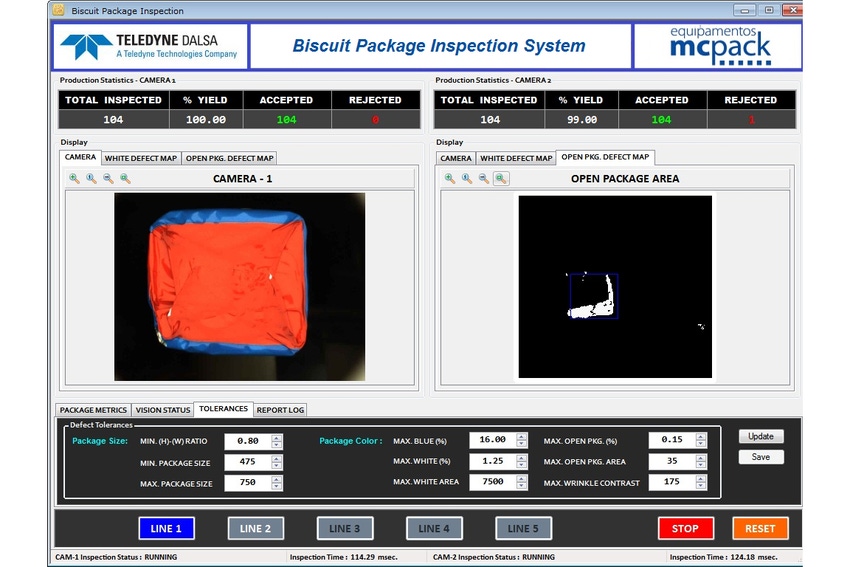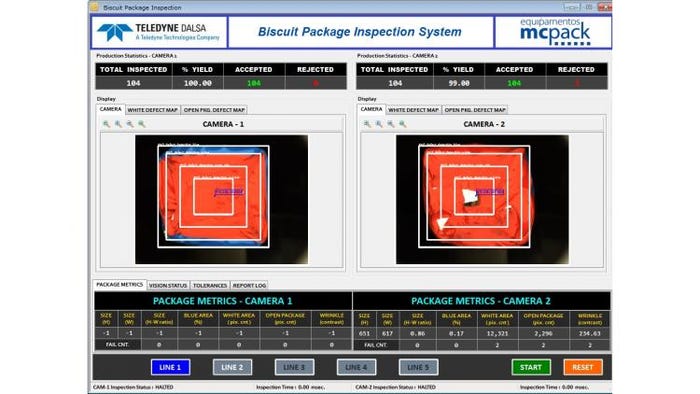High-speed cookie inspection raises quality and cuts costs
November 2, 2015

Automated packaging inspection across 5 production lines at an international food and beverage company in Brazil increases quality assurance, expedites shipments and raises customer satisfaction.
MCPack, a major Teledyne DALSA partner in Latin America, provides innovative inspection solutions to help its customers in the food and beverage, cosmetic and pharmaceutical industries ensure the quality and integrity of product packaging. One of MCPack’s largest customers in the region is an international food and beverage company that manufactures, packages, and ships cookie or biscuit products from a production facility in Brazil.
The cookie manufacturer, which ships thousands of boxes of its products daily, approached MCPack to discuss ways it could leverage automation to reduce the time required to inspect packages before they were boxed for shipment. It wanted to increase quality control and ensure that the packaging for each product shipped met the company’s high standards.
Depending on the particular cookie or biscuit produced, the customer operates between four and five production lines where packages undergo a final inspection before they are placed in cartons for shipment. In the past, these inspections—and the boxing of packages for shipment—was completed manually: Workers visually checked to confirm that the ends of each package were completely sealed, that seals were folded correctly, and that seals were intact (without tears or holes) as the packages were placed in cartons for shipping.
Robotics add inspection challenges
More recently, as the customer automated the final phases of its production process using robotic technology for packing and shipping, inspection became an even greater challenge.
“Inspecting packages before shipment was a critical step in our customer’s manufacturing process, but the manual inspections they used were time consuming and highly unreliable; it was virtually impossible for workers to check every package. This meant that the final stages of the manufacturing process were slow and cumbersome, increasing the time between packaging and when a product reached store shelves,” explains Marcelo Cozac, MCPack director. “Once production was fully automated and workers were no longer needed to box the products for shipment, manual inspection wasn’t even possible. This increased the likelihood that packages that hadn’t been sealed properly could be brought to market. At a time when consumers have so many choices, ensuring a high level of customer satisfaction and maintaining brand loyalty was vitally important to our customer, and they began to consider options for automating package inspection.”
MCPack has a relationship with Teledyne TapTone that spans nearly a decade and, through their company contacts, learned about Teledyne DALSA’s automated vision inspection systems. “Our customer was highly motivated, but the concept of implementing automated inspections in the final stages of production was new for them, so we wanted to offer a system that was easy to operate, but would deliver highly accurate results,” Cozac notes. “Teledyne DALSA has a proven track record with similar applications deployed for other companies that manufacture food products for consumers. Teledyne DALSA’s level of experience with these inspections was important to us and our customer.”
Smart cameras with embedded vision software
At the brand owner’s manufacturing facility in Brazil, MCPack and Teledyne DALSA collaborated to design and deploy two different inspection systems to accommodate the unique packaging requirements of both square and round cookies or biscuits. The first automated system was developed and deployed to inspect rectangular packages with square ends and incorporates Teledyne DALSA BOA smart cameras with embedded Sherlock vision system software.
A BOA camera is placed on each side of the production line��—across five lines in all—to capture color images with 1024 x 768 pixels’ resolution of both ends of each package. As each package crosses the field of view, the BOA cameras are triggered automatically. The embedded Sherlock software assesses the images of the seal on each end of the packages, checking for the accuracy of folds and seals, as well as for tears or holes. The statistical inspection data is sent via an Ethernet switch from the smart cameras to a central computer for operators to view. Operators can monitor inspection results, adjusting inspection parameters and tolerances as needed.
“Packages are sealed using a heat-based system, so in addition to assuring that the seals are intact, the inspection process also checks for wrinkling in the package wrapper, which can mean that excessive heat was used to seal the package, threatening the integrity of the seal,” says Scott Montgomery, senior applications engineer at Teledyne DALSA, who worked with MCPack to design and implement the application. “All packages verified to meet inspection parameters continue down the line for packing and shipment; any package that doesn’t meet specifications is tagged as defective and discarded.”

Across five production lines, Teledyne DALSA BOA cameras capture color images of the seals on both package ends as they cross the field of view, and then embedded Sherlock software assesses the images: consistent coloration indicates an accurate seal while white areas show potential defects, including tears or holes. Defective packages are discarded.
Second application for tubular pack seals
With the success of the first application, Teledyne DALSA and MCPack developed a second application to inspect the seals on tubular packages with round ends. Teledyne DALSA Genie cameras with 1024 x 768 resolution are deployed across four production lines and integrated with the GEVA300 embedded vision system and Sherlock Professional vision system software. In a deployment similar to that of the first application, Genie cameras are placed on each side of the production line to capture images of each package end; however, in this application, the Genie cameras transmit images to the GEVA300 vision system to be processed and analyzed with Sherlock Professional.
“We deployed this second application a year after the first,” notes Montgomery. “For the first application, one of the customer’s primary goals was convenience, but in this second case, we needed to accommodate a significant quantity of high-quality, color images, which would be generated by eight separate cameras across four production lines. To ensure more efficient image logging and viewing, we’ve incorporated a localized vision processor—the GEVA—into the design.”
Done at speeds of two per second
Since the first automated package inspection solutions have been in place, MCPack’s international customer has seen significant results. With both applications, packages are now inspected at a rate of two packages per second, for faster, more accurate quality assessment. “Operationally, the customer has realized increased production rates, as well as labor and time savings,” Cozac concludes. “Products are packaged for shipment much more quickly than ever before. A single inspection system operator now does the work of multiple employees who used to be needed to check packages manually, which significantly reduces manpower costs. Finally, our customer can be confident that their quality control efforts are working and know that all the packages of these products on store shelves meet their high standards. The customer believes that their buyers will notice the high quality packaging and this will result in higher customer satisfaction.”
The international food and beverage company is currently considering the potential of implementing additional automated systems on other production lines to inspect the packaging of products such as candy before they are shipped. In addition, MCPack has begun to design and develop similar inspection systems for other manufacturers in the region.
Scott Montgomery is a senior applications engineer for Teledyne DALSA, Billerica, MA. Montgomery has more than 25 years’ experience designing, developing and integrating vision systems, and holds a B.S. in Engineering from Northeastern University.
___________________________________________________________________________________
Want to know more about packaging? Learn about the latest developments in packaging innovation at SouthPack 2015, Nov. 18-19, in Orlando, FL.
___________________________________________________________________________________
About the Author(s)
You May Also Like


